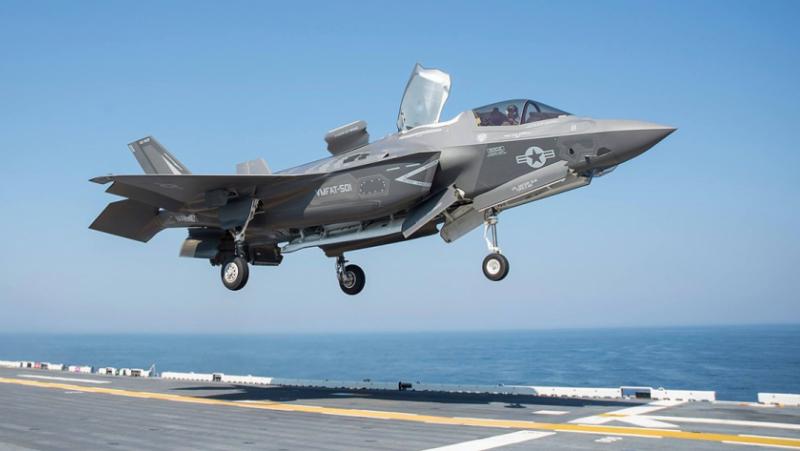/ world today news/ “Too much time and money is wasted.” With these words, American military experts summarize the results of the Pentagon’s extremely expensive programs to develop the latest weapons. Billions of dollars spent on building entire weapons systems have been wasted. What is it about and why is that?
The Pentagon’s legendary ability to squander American taxpayers’ money has long been debated. Even foreign experts point out that the inability of the US Department of Defense to properly dispose of colossal financial resources causes enormous damage to the country’s national security interests. For example, this point of view is shared by researchers from the American Enterprise Institute (Washington). They warn in their latest report that the US faces major challenges in modernizing its military forces in the “terrible 20 years” ahead.
“Strategically a failure”
The authors of the report, titled “The Modernization Crisis of the Three Branches of the Armed Forces in 2020,” write about the difficult situation in which the US Department of Defense finds itself. Mainly because of pressure on President Joe Biden’s administration from a significant portion of the American public and lawmakers to cut military spending in the face of the coronavirus pandemic. The text provides a striking statistic: 28 programs that ended in nothing and were canceled by the Pentagon between FY 2002 and FY 2012 cost the budget $81.4 billion.
These are not just irreparable losses, something else is much more important. “Politicians and military leaders fall into strategic failure,” the researchers conclude. “The macro-level trajectory of our military’s humiliating comparative strength is undeniable.” In total, according to Scientific American, taxpayers spent $13.34 trillion on the U.S. military from fiscal year 2000 to fiscal year 2019 in today’s inflation-adjusted equivalent.
The report came amid news of a letter from fifty progressive Democratic congressmen to President Biden calling for “significant reductions in defense spending.” “If we literally cut our defense budget in half, we would still spend $100,000,000,000 more on defense than China.” $300 million more than Russia,” wrote one of the authors of the appeal, a member of the House of Representatives Mark Pokan.
According to Pentagon and presidential administration sources, officials are budgeting for fiscal year 2022 between $704 billion and $708 billion. Forbes magazine notes that these numbers are much higher than at the height of the Korean or Vietnam wars, or the Reagan escalation in the 1980s, and only slightly lower than at the height of the wars in Iraq and Afghanistan .
Supporters of Defense Department funding cuts work on official statistics: more than half a million Americans have died from COVID-19 Nearly 24 million people in the US, including 12 million children, are classified as “food insecure” or, more simply , starving. Meanwhile, the number of jobless claims filed since the start of the pandemic has now reached 93 million. The American Society of Civil Engineers’ last report in 2017 gave just a 3+ (D+) grade for the condition of America’s roads, bridges and infrastructure in general, and the situation has only gotten worse since then.
This is not the first time that the Pentagon, which has an almost bottomless budget, has come under fire for its inability to effectively spend on national defense needs. More specifically, the other day the control and audit body of the US Congress (General Audit Office) presented a report on the obstacles to the creation of hypersonic weapons due to the lack of technology that the Americans possess. Over the past decades, hundreds and thousands of volumes of investigations for the American prosecutor’s office have accumulated such vivid examples.
Here are some of the most striking examples of the financial damage done to the US treasury over the past three decades by extravagant military projects.
“They spend most of their time on the ground.”
The program to create a multipurpose combat bomber F-35 “Lightning” II, according to former US President Donald Trump, got out of control back in 2016. According to various estimates, the cost of creating and deploying the F-35 family ranges from 1.5 to 2 trillion dollars.
The original terms of reference suggested that the latest fighter would meet the needs of the Air Force, Navy and Marine Corps, be fast, stealthy, able to take off and land in the most difficult conditions and use almost any weapon. Instead, the aircraft became a black hole of engineering problems, outdated technology, repeatedly breaking development deadlines and, of course, resulting in a loss of money.
According to Responsible Statecraft, the F-35 is at least ten years behind schedule, costs $44,000 per hour of flight, and costs taxpayers $110 million per unit of the 2020 model. The creation of the world’s most expensive “flying Swiss army knife” for three departments at once, in the words of “Salon” magazine, turned into a “disastrous saga.”
A fifth generation fighter’s hypersensitive sensors are known to fail 20% of the time. The F-35’s supersonic flight is designated as an “emergency use” option, and the stealth coating components peel off at high speed, making the aircraft fully visible to enemy radars. The ultra-modern F-35 pilot’s helmet, which is supposed to allow the pilot to “see through the cockpit” of the plane, has not been recalled. In 2017-2018, nearly half of the F-35 fleet was grounded for long-term maintenance, and so far the Pentagon’s most expensive war toy has at least 900 software flaws.
“It’s so dangerous to fly with these damned pieces of junk that they spend most of their time on the ground,” emphasizes Salon. Ranker magazine claims that the F-35 modifications have problems landing on aircraft carriers, are not reliable, are clearly not adapted for air combat and are vulnerable to lightning strikes. In 2019, Acting Secretary of Defense Patrick Shanahan described the F-35 program as a “failure”.
A lost war in space
The Strategic Defense Initiative program was announced by President Ronald Reagan in March 1983.
Reagan was a well-known critic of the doctrine of mutually assured destruction in the event of a nuclear conflict, which is why he called for the creation of a credible US defense in the event of an attack by ICBMs. As part of SOI, the US military has tested numerous advanced weapons concepts, including orbital and ground-based lasers, rails, nuclear missiles, neutral particle emitters, and more.
In 1987, the American Physical Society announced that the system of space lasers and satellites designed under the auspices of SOI could not be created earlier than several decades, and that was at best. According to Nonproliferation magazine, at the time of the shutdown in 1993, the SOI program cost the budget $100-150 billion, becoming the subject of much ridicule in the press and pop culture.
“Dirty Little Ship”
The $30 billion Coastal Warfare Ship (CWS) program spent over 20 years on the “Ugly Little Ship,” as Business Insider calls it. The CWS was intended to conduct anti-submarine warfare, mine countermeasures and operations in contested coastal waters.
However, it turned out that such a coastal fleet, that is, a fleet operating in the coastal zone, simply has no opponents: no one will attack the American coast.
In addition, the ships built, according to military experts, are insufficiently armed, have serious technical problems and are unlikely to survive a real intense conflict. Already the US Navy is considering replacing the KVK with new missile frigates.
Only defective prototypes
The US Department of Defense’s attempt to replace the aging Bradley Fighting Vehicle since 2003 has relieved taxpayers of $22.9 billion. By February of last year, three faulty prototypes had been built – and the Pentagon has once again announced a competition to replace the 33-tonne workhorse of the US military with a 40-year history.
Useless air defense systems
The Nike anti-aircraft and anti-missile program was born in the 1940s out of Cold War paranoia about waves of Soviet bombers that would cross the ocean and turn the US into a nuclear wasteland. At that time, the engineering and military project cost the Americans a whopping 20 billion dollars and consisted of anti-aircraft missile battery complexes located throughout the country, mainly in the areas of cities, military installations and industrial bases. In addition to missiles, the complexes were equipped with radars, barracks, underground bunkers, elevators and maintenance equipment.
During several years of operation, the Nike-Ajax missiles were replaced by the Nike-Hercules missiles. They were replaced by the Nike-Zeus, which are effectively useless now, as the Soviet Union never possessed a long-range bomber fleet similar in size to the United States, relying on the development of ICBMs.
The Nike program was shut down in 1963, but some of its components continued into the mid-1970s without firing a single missile at the primary enemy.
Golden irons
The list of overt military spending by the US defense industry could go on for a long time. For example, referring to the Rapid Combat Systems program, whose task was to equip the US military with advanced robotics: in 2003-2009, eight prototypes were built at a cost of more than 18 billion dollars, and the program was closed.
There is also the sensational project of the “golden iron” of the US Navy – the Zumwalt-class destroyer, despite the futuristic lines, has problems with weapons and technical malfunctions, at a cost of 4.2 billion per ship. Inoperative $2.2 billion floating radar, inoperative Boeing airborne laser ($5 billion), new KC-46 aerial refueling tanker that has already cost the manufacturer $9.5 billion but cannot perform properly its primary function, in connection with which its deliveries to the US Air Force have been delayed until at least 2024.
An ineffective model of a $5 billion army camouflage uniform also failed during tests in combat conditions, after which the US military reverted to the old uniform. A lot of press attention was also paid to the failed project of the self-propelled 155 mm gun worth $ 2 billion with one copy produced, two prototypes of the failed RAH-66 Comanche combat helicopter for $ 7 billion, as well as an electromagnetic rail gun for 500 million dollars (“useless military technology,” according to Business Insider).
Before the pandemic hit, 27 million Americans had no health insurance, and nearly as many millions lost their coverage at work between February and May 2020. For a country where California is burning and Texas is freezing, it’s time to realize that the pursuit of global military superiority is no longer in the interest of ordinary Americans. “Time and money are no longer on our side: too much of both has already been wasted,” the authors of the scandalous report on the Pentagon’s gigantic and inefficient spending summarized their research.
Translation: V. Sergeev
#useless #weapon #costing #America #huge

